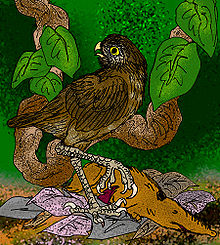- Ornimegalonyx
-
Cuban Giant Owl
Temporal range: Late Pleistocene
Scientific classification Kingdom: Animalia Phylum: Chordata Class: Aves Order: Strigiformes Family: Strigidae Genus: †Ornimegalonyx
Arredondo, 1954Species The Cuban Giant Owl or Giant Cursorial Owl (Ornimegalonyx) is an extinct genus of giant owl. It is closely related to the many species of living owls of the genus Strix.[2] It was a flightless or nearly flightless bird and it is believed to be the largest owl that ever existed. It lived on the island of Cuba.
The first fossil specimen was mistakenly described as a bird in the family Phorusrhacidae, in part because the bones were so large. In 1961, Pierce Brodkorb reviewed the findings and placed them properly, with the owls. Remains have been abundant throughout the island, in cave deposits from the Late Pleistocene period (10,000s of years ago) and at least three nearly complete skeletons have been found.
"Ornimegalonyx arredondoi" is a nomen nudum; the name was proposed for this species before it was described but oteroi was eventually adopted by Oscar Arredondo (according to the rules of the ICZN, naming a species after one's self is not prohibited, but it is frowned upon as vain by the scientific community).
Contents
Description
Arredondo estimated the height of Ornimegalonyx to have been 1.1 metres (43.3 inches) tall and it probably easily exceeded 9 kg (20 lb).[3]It had very long legs for its size, but was bulky overall and probably short-tailed. The modern owl that most resembles the Giant Cursorial Owl in proportions is probably the dainty Burrowing Owl, the only surviving owl closely tied to the ground. This implies similar adaptations to the terrestrial lifestyle, but not a close phylogenetic relationship.
One of the largest living owl, the Eurasian Eagle Owl (Bubo bubo), reaches 4kg in weight, and Peters (page 188) has reported them taking Roe Deer fawns that weigh 17kg as prey[4] This suggests that Ornimegalonyx could have killed prey of 35kg or more. Modern owls are known to use a pouncing strategy - where they drop from elevated perches onto prey, spreading their wings only just before hitting their target. [5]. The modern Kakapo (Strigops habroptila)[6] is a flightless island parrot and is convergent, in some ways, with owls. Like Ornimegalonyx, it is the largest and heaviest member of its family, it has reduced wings, and a reduced keel of the sternum, but it can parachute by leaping from trees with its wings outspread, potentially covering several meters at an angle of descent less than 45 degrees. [7] [8]
The legs and feet of the Giant Cursorial Owl appear to be very large and powerfully built. This supports the theory that they were strong runners, hence the title of cursorial. The keel of the sternum was reduced and the owl may have been capable of short burst of flight. It is probable that, like a modern wild turkey, the owl only took flight when extremely pressed, more often choosing to run.
Diet
The Giant Cursorial Owl is believed to have preyed principally on large rodents including Heteropsomys, Capromys, Geocapromys, and Macrocapromys (the size of modern nutria or capybara) and the ground sloths Cubanocnus, Miocnus, Mesocnus, and Megalocnus.[3] It was probably an ambush predator that would pounce on unsuspecting prey with its crushing talons.
See also
- Tyto pollens
- Grallistrix
- Late Quaternary prehistoric birds
- List of extinct birds
- List of fossil birds
- List of extinct animals
- Flightless birds
References
- ^ a b c Arredondo, Oscar (1982). Los Strigiformes fósiles del pleistoceno cubano. Boletín de la Sociedad Venezolana de Ciencias Naturales 140, 33-55.
- ^ Feduccia, Alan (1996) "The Origin and Evolution of Birds" Yale University Press
- ^ a b Arredondo, Oscar (1976) translated Olson, Storrs L. "The Great Predatory Birds of the Pleistocene of Cuba" pp. 169-187 in "Smithsonian Contributions to Paleobiology number 27; Collected Papers in Avian Paleontology Honoring the 90th Birthday of Alexander Wetmore"
- ^ Andrews, Peter (1990) "Owls, Caves, and Fossils: Predation, Preservation, and Accumulation of Small Mammal Bones in Caves, with an Analysis of the Pleistocene Cave Faunas from Westbury-sub-Mendip, Somerset, UK" University of Chicago Press. 231pages. ISBN 0226020371, 9780226020372
- ^ Burton, Robert (1990) "Bird Flight" Facts on File Oxford, UK. 160 pages ISBN 0-8160-2410-3
- ^ David, N. & Gosselin, M. 2002. The grammatical gender of avian genera. Bulletin of the British Ornithologists’ Club, 122: 257-282
- ^ Livezey, Bradley C. (1992) "Morphological Cprollaries and Ecological Implications of Flightlessness in the Kakapo (Psittaciformes: Strigops habroptilus)" Journal of Morphology 213:105-145 (1992)
- ^ Powlesland, Ralph G., Merton, Don V., Cockrem, John F. (2006) "A parrot apart: the natural history of the kakapo (Strigops habroptilus), and the context of its conservation management" pg. 3-26 in Notornis, Volume 53(1), 2006
Categories:- Owls
- Strigidae
- Genera of birds
- Pleistocene birds
- Extinct flightless birds
- Prehistoric birds of North America
Wikimedia Foundation. 2010.
